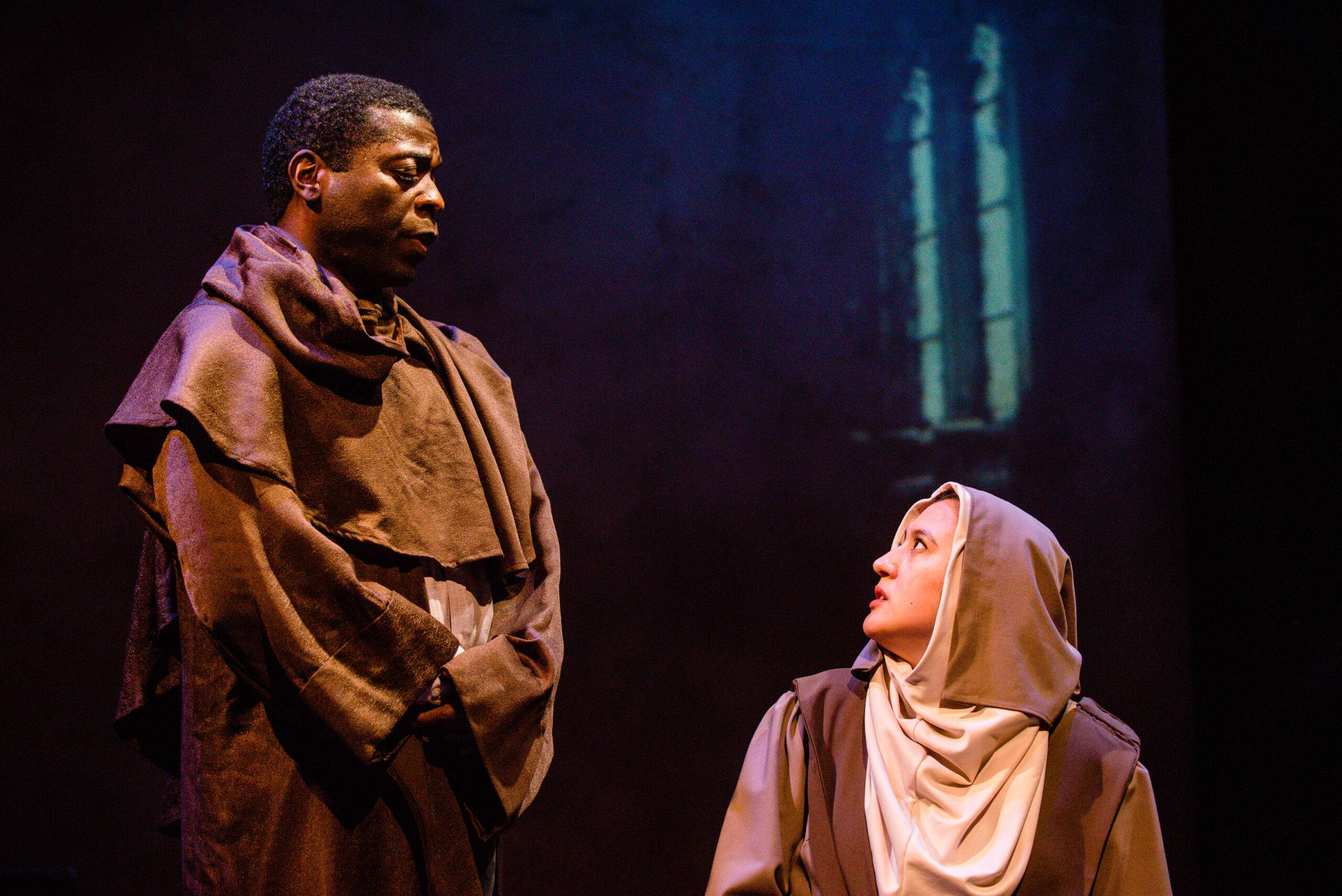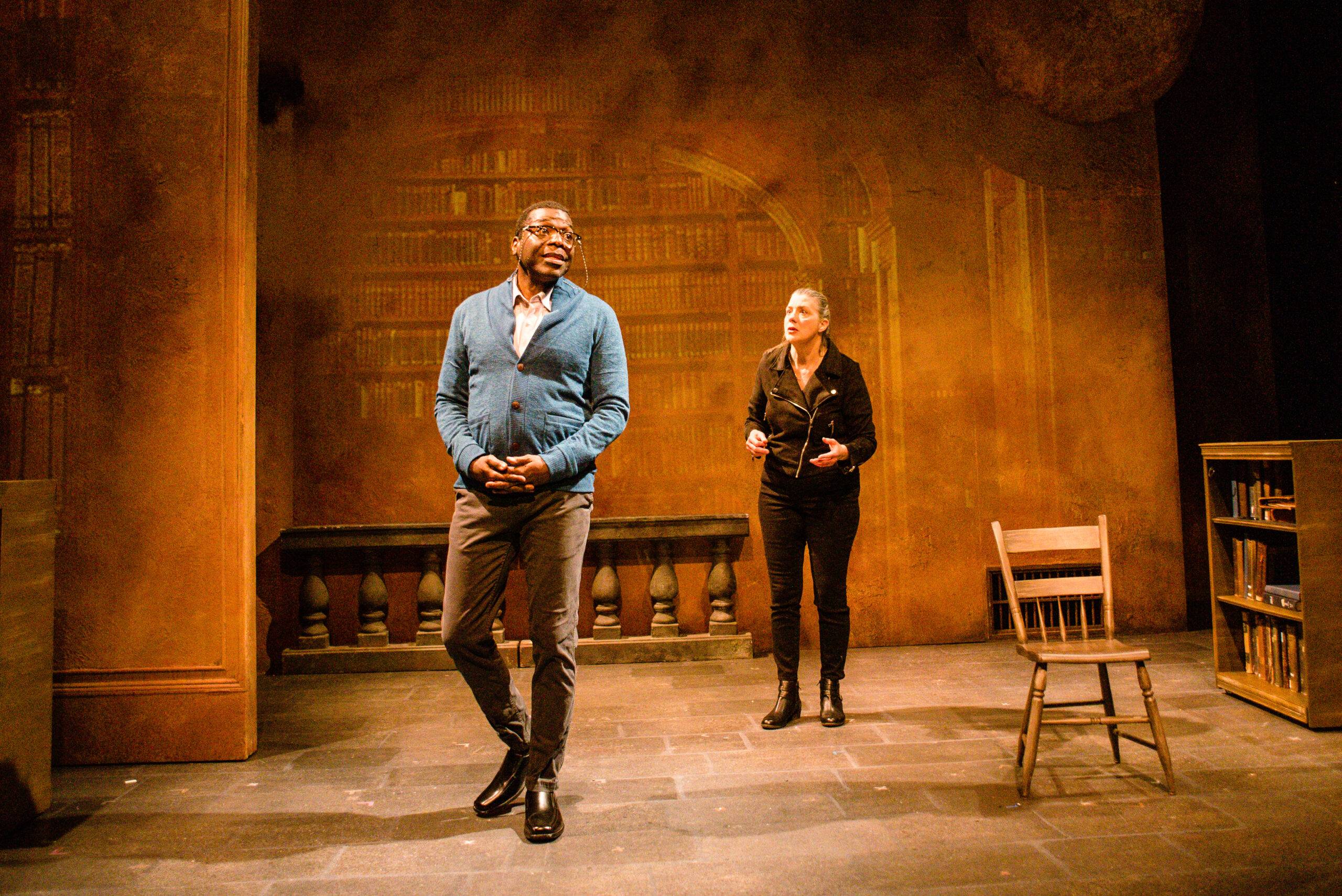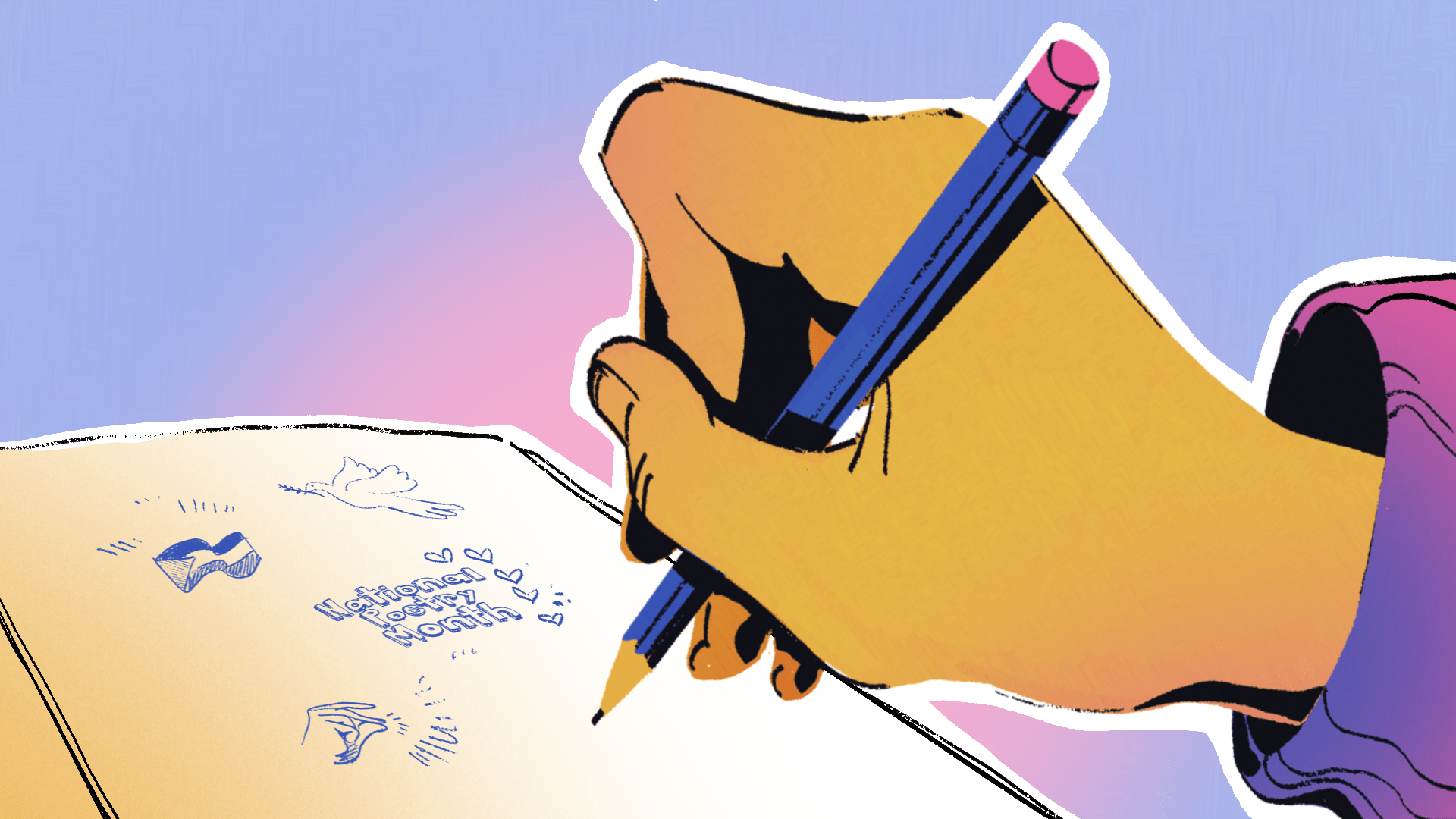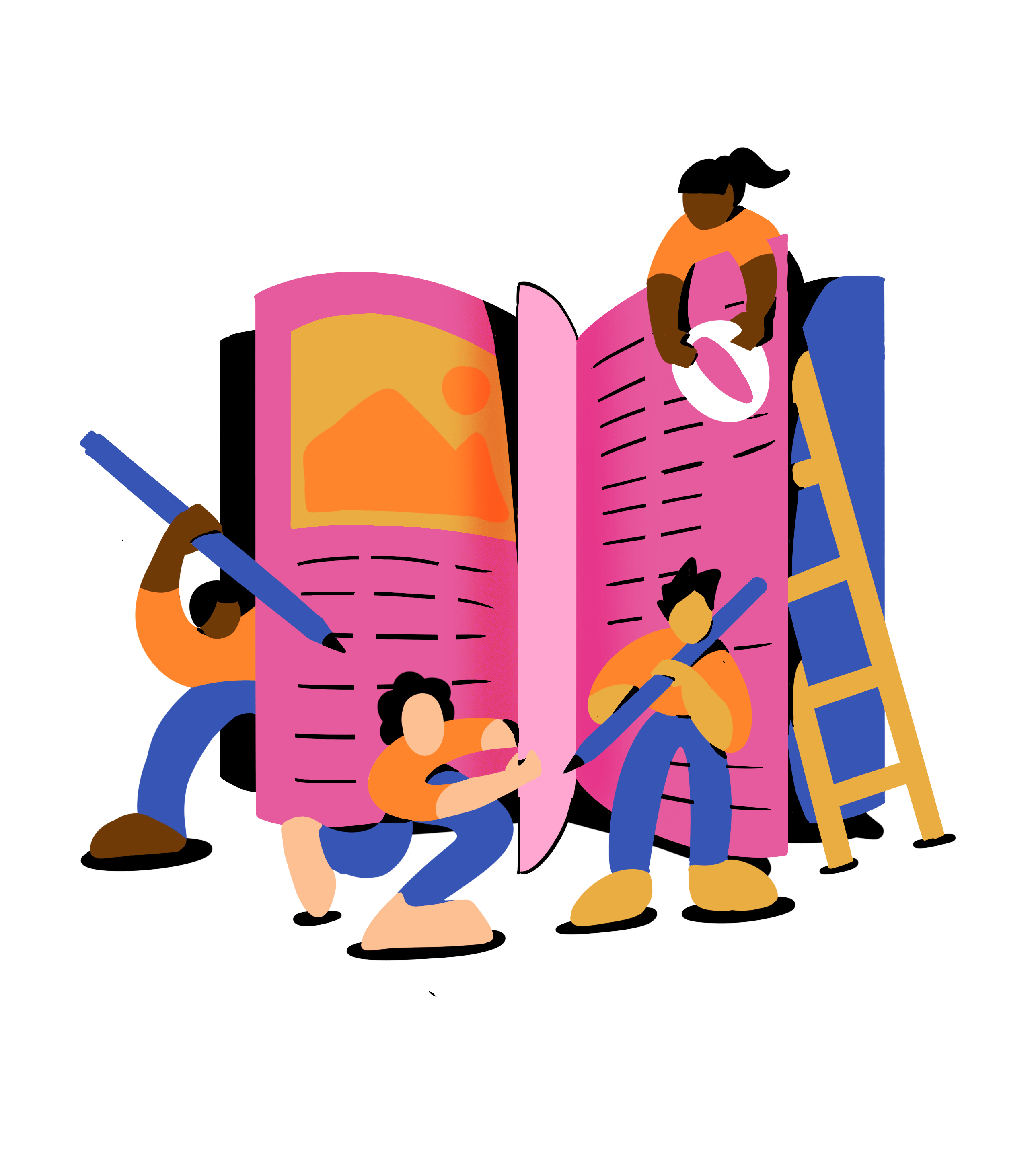
Chiké Johnson (Galileo) and Emily Bosco (his daughter) in one of the scenes of the play. Photos by Jose Uribe
Remy Bumppo Theater Company presents a new work “Galileo’s Daughter,” directed by Marti Lyons, from April 5 to May 14, 2023. Jessica Dickey, the playwright, wrote the script based on Dava Sobel’s novel “Galileo’s Daughter” (1999) — a novel that draws references from the collection of 124 letters between Galileo and Maria Celeste, his daughter. The story narrates a heartbroken playwright traveling to Florence to research the letters. This journey also navigates across an alternate timeline where she encountered Maria and Galileo.
To enable this time travel, this piece skillfully employs projections to set scenes. John Boesche is the projection designer of this theater work. He is an associate professor of Media Design at the University of Illinois at Urbana-Champaign and an alum of the School of the Art Institute of Chicago (SAIC). In this extensive interview, Boesche shares his experience with the design and collaborative process.
GF: How does your study at SAIC inform your practice? How does your collaboration with Remy Bumppo progress?
JB: I’m an alum of the SAIC, and my study was in interior architecture. I had two professors who used the media a lot in their lectures. It kind of got me interested in that. While I was there, there were lots of people who were doing performance art and at the same time, I was dating a young woman who later was my wife of 38 years, who was a dancer. I started meeting all these people in performance art or dance. And so they started doing media for those kinds of things. I often do more experimental kinds of work and performance rather than strictly speaking theater-based work.
Collaboration with Remy Bumppo, though follows more of the model of a traditional theater production where we start with a script and the director reads and decides to take on that script, they audition both performers and design team and start to pull together the team that is going to be both on the performance and then on the design end. I was very happy to meet and be invited to work with Marti Lyons, who is our director. That’s an exciting part of this project, was to work with both a new director and a playwright who was new to me on an original script. The process with Marti was great. She likes to bring the whole design team together. There were exchanges of ideas about what we thought this piece would look like, and how we might approach telling the story. From there, I begin to make images of some ideas of what I think my projections might look like on the set based on photographs of the set model. And then I could communicate that with the rest of the team. There’s a lot of give and take in the preparation before we get into technical rehearsals.
This particular show does one of the features of projections or explores a part of its potential, and that is to project locations and landscapes, sometimes real and physical, but also sometimes kind of the internal landscape or the psychological landscape of the characters. This piece changes locations a lot. I think there’s one stretch where in less than two minutes we change locations five times. So that is a part of the storytelling where to keep the momentum of the story moving forward. We need to establish those locations very quickly with projections.
Once we were in the theater, we discovered that the imagery that we decided on is not as impressive in the space with our team. So we start making changes very quickly. The process of technical rehearsal is both bringing what we think we wanted to see to the stage and, and realizing that. It’s also being open to recognizing that what we thought was going to work doesn’t.
GF: What was the previous collaboration like?
JB: Remy Bumppo, like many other theater companies, has had a lot of changes. In the past two or three years, the pandemic caused a lot of theaters to close. A lot of people did a lot of examinations of where they were in their careers. How did they want to try and make ends meet? This was a time when you were taking a break and reconsidering. Many theaters have had a lot of changes in who’s working in the theater, who the creative team is, and who’s providing the artistic direction.
I had worked with the previous artistic director, Nick Sandys and we had a great collaboration together and worked on a number of projects, even outside of the theater. I also admire Marti Lyon’s work, the new artistic director. She brings a lot of great experience and a wealth of interesting creative relationships with other folks. She is a new person to work with me, and I was very excited by her energy and she really digs deep into the script, as most directors do.
She does an outstanding job of directing what to bring to the designers, what to bring to the cast, and what to bring to the audience and pulling all of those threads together. I loved her energy and her innovation and just a very fresh sort of point of view on how she approaches theater-making.
GF: How does the story of Sister Maria Celeste and Galileo connect to our contemporary world?
JB: The relationship between Galileo and his daughter was first made known to the public in 1999 by Dava Sobe’s book called “Galileo’s Daughter: A Historical Memoir of Science, Faith, and Love.” And I read the book when it first came out. She’s a brilliant writer and a really serious researcher. This book inspired our playwright Jessica Dickey. Her innovation was to combine the story of the relationship between Galileo and his daughter and a journey of a playwright, female playwright who goes to explore those letters and it has some autobiographical resonance with the playwright’s own experience.
The contemporary interest in that story is the comparison to the options that were available to Galileo’s daughter, who we learn is brilliant, passionately committed to her relationship with her father, and a very, very ardent worker and was particularly ardent as a writer, both a writer of letters, but also in corresponding with her father and on behalf of her father, but also she transcribed and copied many of his own ideas and writings, and so was his assistant, functionally.
Her life became very different from the life that’s represented by the writer in the play in that the recognition is that this playwright has so many greater freedoms and opportunities as a woman in today’s world, but she still has the challenge of creating her own freedom by taking control and using the power that she has.
One of the analogies that’s used between the two is there is an imagined meeting between Galileo’s daughter who lived in the 1600s and the contemporary playwright. In that exchange, Galileo’s daughter looks at this modern playwright and says, “You’re wearing pants! That’s brilliant!” Suddenly she realizes how liberating it would be simply to be able to not be stuck in the gender role of needing to wear a dress or a robe at all times and the freedom that would provide.
GF: How does projection design connect to this piece of history? And how projection helps to amplify this kind of narrative?
JB: The challenge for this particular storytelling was to be historically accurate in many of the locations; and at the same time be narratively accurate, meaning to have something of the mood and the character and the psychology of what’s happening emotionally in a given scene. When the main character talks about going to the Museo Galileo, that is slightly altered, but basically it is a photographic view of that museum in Florence, but modified and the proportions changed a little bit to fit our set.
When we are in the San Matteo Convent, where Maria was forced to become a nun, that is definitely imagery from convents. But it is more important in that case to be accurate to the emotional character of the scene rather than specifically.
So there’s a balance moving back and forth between making a historically or geographically accurate representation. At the same time, trying to find the emotional and psychological space where this scene is taking place.
GF: Theater Wit is really an intimate space to depict the intimacy between a daughter and a father. What would be the major difference when designing projections for theater and opera?
JB: Yes, I agree with you 100%. I love that piece. In that intimate space in theater Wit, where there is that proximity and physical intimacy between the audience and the performers. I think that works very well for this piece, much of which is extremely fast-paced. So a part of what I’m doing is sort of bringing the audience along for the ride. Now we’re here, now we’re there, now we’re moving very quickly through one place to another and trying to feel like we authentically occupy that space or those characters do. But other times we need to step back a little bit and just let those actors do what they do best and tell the story and share the intimacy that they have found in their characters with the audience.
An opera house situates three to four thousand people. The importance of the projections is very, very different. The audience is very often quite distant from the performers. In opera, their craft is developing a kind of intimacy with the audience, but it’s mostly getting a huge voice that can communicate that part of the character for this enormous room for a very large audience. That’s physically distant. So the projections need to have scale and power and the ability to draw the audience into the story in a more emotional way, possibly a more abstract way.
I actually encourage my friends who are going to see this piece in that space, that theater with to actually be back a little bit, because even if you’re in the back row there, you’re still closer to the performers than you would be if an opera singer was all the way downstage and you were in the front row. It’s just such a nice, intimate space that you never lose the performers in the theater. But in an opera house, the performer is going to be a tiny little speck a long way away. We need to create something of scale and power to draw the audience in and focus them on the story and the voice.
GF: Do you consider site specificity in your work?
JB: I’m happy that you mentioned that. That was actually where I started as an artist. When I was at SAIC, I was doing specific installations using media, typically using projectors. When I got started, I was using slide projectors and film projectors. And then, digital video sort of happened as I was practicing.
So I incorporated that into my work. I was very excited to be able to explore that. I started doing analog video and editing, etc. But yes, specificity is very important to me. And I think more scenic designers are addressing more and more those venues that a theater with, look very neutral, but in fact, they each have their kind of personality and quirks that need to be incorporated into the set.
That looks very kind of symmetrical but with just a little subtle asymmetry. But that is in part motivated by how to get the actors on and off. We’re working to make a crossover not visible to the audience. Where can they go to make a costume change? So all of that needs to be considered. And I consider that too, when I’m programming and seeing the images on the set for the first time, I move around in every seat in the house, basically to understand what someone sees from this point of view.
What do they see from that point of view? Every person that’s going to see this will have a different experience. Every person is important. I need to ensure that what they’re seeing makes sense or at least will help frame the story. So the story comes through to the audience from every seat.
GF: What are some advantages or challenges you have encountered using projection over a traditional theatrical background?
JB: I also design scenery, but typically it’s scenery where the idea is that a lot of it will be projected. But there are things that the projections do very, very well. And there are things where I have more respect for people who are artistically developed to create beautiful work that doesn’t involve projection.
So more than once I’ve had people come to me and say, we need to project a really big, beautiful sky for this production and we’re doing it in this venue and we want you to do that. And I have, again, on more than one occasion said, you know what, in that venue is not a good place to park a projector.
And some people paint beautiful sky backdrops and the names of three that I would recommend. The producers are always shocked. I’m talking myself out of a job. But I think it’s important to respect that there are different qualities and characteristics of each of those disciplines. Scenic art painters, sculptors who do that work for creating work on the stage, or visual artists who are creating work for performance art.
They are building things out of either found objects or they’re fabricating something completely original. But that kind of sculpture and creation of an immersive environment is its art form and discipline that I have a lot of respect for. Sometimes projections are part of that. The times that projections do not work or when you simply don’t have the budget for a bright enough projector to create a compelling image.
I think you’d be better off building and painting some of this and let’s work on another project when the specificity of the site we’re working on and the budgets and all of those things, and then the timeline can all come together to make this a successful projection project.
GF: Have you made any production with multiple projections for a more immersive theatrical environment?
JB: I often will combine the scrims, and LCD monitors with some projected media, certainly multiple projections on multiple surfaces, combining imagery so that it may be projected on a scrim and an actor may appear behind that scrim. Or that’s when this stuff gets interesting when you can’t quite tell where the scenery ends and the projection begins and where the projection ends and the lighting begins and where the lighting ends and the scenery begins.
When all of that becomes blurred is where it becomes much more interesting to your specific point about multi-channel video and work like that, I’m just starting work now with a performance and media artist named Dick Weaver, who also teaches at the University of Illinois. But he does these performance works that are enormous in scale.
He’s conceiving a piece right now that will have two screens that together are 100 feet wide. And then there are two auxiliary screens on the edge of that. So this will be two very large projectors and then just large projectors, but multiple video sources for that. So sometimes we want all of that to be a unified image.
But parts of that piece will be inserting little images and text and realistic imagery, abstracted animations, etc. So building up different layers of media is definitely of interest and it kind of depends on what the work is.
What’s the nature of storytelling? How much narrative do you need and how much of it is more about letting imagery and performance and spoken word and sound just kind of wave over the audience and create a world and an impression without necessarily having to be specific about a story that starts at point A and ends at point B, right?
GF: How do we create a balance so that we are not competing with the narrative or acting or like other works of artists?
JB: Usually the first time I start working with a new choreographer or performance artist or director, I start by saying, I think it’s my job to create something interesting, but not more interesting than what the performers are doing.
There are times when that is our job, and there are many times when you refer to how important it is to recognize just the practicality of the situation we work in more than once. I have and I often have advised students that it’s okay to have to do this. I’ve more than once been asked to produce a piece of media to cover a one-and-a-half-minute costume change or a two-and-a-half-minute scenic change. What can you do that’s going to distract us and keep the audience interested? There are times that we need to move to the foreground and then other times that we need to pull back.
I often, as a strategy when we’re changing from one scene to another, include motion video, and then when the scene begins, slow that down and then pause on a still, because we don’t want to have motion running continually through a scene. It’s important to pay attention to the words that the performer is saying so that we don’t lose what they are either saying or what their performance is.
It’s important to know when to be in the driver’s seat and when to be in the back seat. I often tell students that I like all the seats in the car. I like to be in the driver’s seat sometimes. I like to be in the passenger seat reading the road map and telling the other person where they should be going. Sometimes I like to be in the back seat and generally take a nap and wake up occasionally to say, “Oh, did you see this?”
I think what a media designer should do in collaboration is to continually think about which seat is in. Is it time for you to drive? Is it time for you to sit in the back seat and just kind of ride along with someone else who’s in charge? It can change many times during a given performance work and may change from one piece to another.
GF: What advice would you give to a younger generation of new media arts?
JB: One is continually looking forward, learn as many new tools as you can. Pay attention to the technology, and try to understand it. Don’t get lost in spending all your time dealing with technology. But the other one is to also look over your shoulder just as you are and look at what were the ideas in art that created innovation at an earlier time.
What is still fertile? What are the artistic ideas of, for instance, Cage and Cunningham that you can bring to your contemporary practice? It is that combination of looking forward and looking back at the same time to derive inspiration and understanding and focus on the ideas, but at the same time to become aware of the tools and the opportunities that are continually evolving and becoming available for you.























